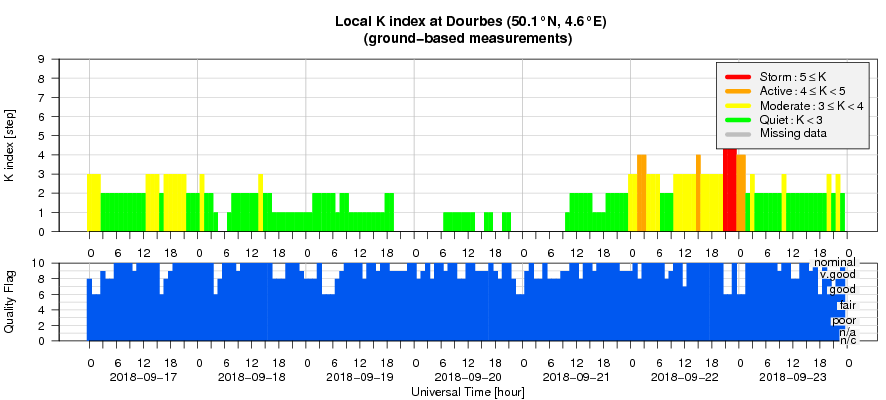- Table of Content
- 1.Counting down ...
- 2.Review of sola...
- 3.The Internatio...
- 4.PROBA2 Observa...
- 5.Review of geom...
- 6.Geomagnetic Ob...
- 7.The SIDC space...
- 8.Review of iono...
2. Review of solar activity
3. The International Sunspot Number
4. PROBA2 Observations (17 Sep 2018 - 23 Sep 2018)
5. Review of geomagnetic activity
6. Geomagnetic Observations at Dourbes (17 Sep 2018 - 23 Sep 2018)
7. The SIDC space weather Briefing
8. Review of ionospheric activity (17 Sep 2018 - 23 Sep 2018)
Counting down to the Open Doors
On Saturday 29 and Sunday 30 September 2018, the Space Pole (the Royal Observatory of Belgium, the Royal Meteorological Institute and the Royal Belgian Institute for Space Aeronomy) will open its doors to the public.
The program includes activities for young and old. You can visit the telescopes, the climate center or the virtual weather office. Or you can follow one of the many thematic lectures. The creation of aurora in a dark room will surely amaze you, and you can learn everything you ever wanted to know on the study of the Earth, planets, moons and comets from our own solar system to far beyond in the universe. Our scientists will be happy to discuss with you at the various information stands and will also animate workshops and live scientific experiments. There are also plenty of activities for children. A picnic area and foodtrucks will be available on site.
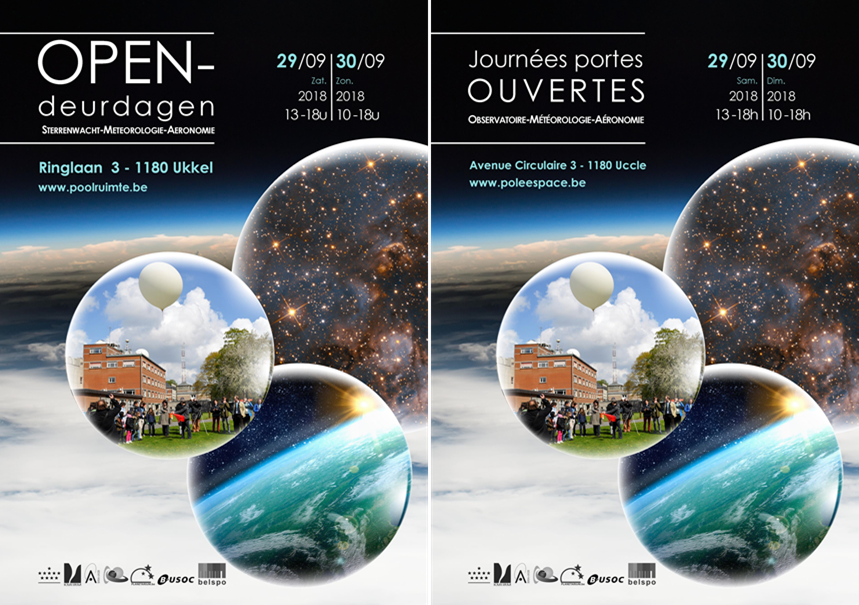
The STCE will organize and participate in numerous activities. The solar dome and the solar telescopes will be accessible which allows -weather permitting- to observe the Sun. Space weather forecasters will explain how they (try to) predict the conditions on the Sun and in space, and the PROBA2 Science Centre will have a full-scale model of the PROBA2 solar satellite. A visit of the SSCC, the first European Space Weather Helpdesk, as well as of the Planeterrella, an impressive auroral simulator, is highly recommended. In the experiments tent, scientists will reveal the mysteries behind spectroscopy and how they use this tool in their research. You can also get acquainted with how to draw and classify sunspots.
The full program can be found at the Open Doors 2018 website:
- in Dutch: http://spacepole.be/index.php/nl/opendeurdagen-2018
- in French: http://spacepole.be/index.php/fr/journees-portes-ouvertes-2018
At most of the stands, explanations can also be given in English.
Review of solar activity
Only two numbered solar regions were observed. Catania sunspot group 95 (NOAA AR 2722) and Catania sunspot group 96 (not numbered by NOAA), which emerged on September 19 and decayed very fast without producing any flares: none in the C-class and not even in the B-class.
There was no wide or Earth-directed CMEs observed, and the solar protons remained at the background level during the whole week.
Two coronal holes were observed.
A low latitude extension of the northern polar coronal hole reached the central meridian on September 18. A very patchy equatorial coronal hole reached the central meridian on September 19.
The International Sunspot Number
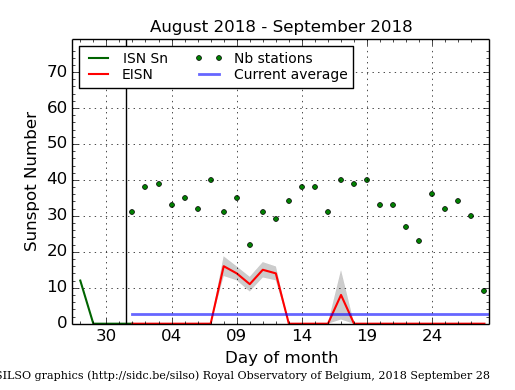
The daily Estimated International Sunspot Number (EISN, red curve with shaded error) derived by a simplified method from real-time data from the worldwide SILSO network. It extends the official Sunspot Number from the full processing of the preceding month (green line). The plot shows the last 30 days (about one solar rotation). The horizontal blue line shows the current monthly average, while the green dots give the number of stations included in the calculation of the EISN for each day.
PROBA2 Observations (17 Sep 2018 - 23 Sep 2018)
Solar Activity
Solar flare activity was very low during the week.
In order to view the activity of this week in more detail, we suggest to go to the following website from which all the daily (normal and difference) movies can be accessed: http://proba2.oma.be/ssa
This page also lists the recorded flaring events.
A weekly overview movie can be found here (SWAP week 443).
http://proba2.oma.be/swap/data/mpg/movies/weekly_movies/weekly_movie_2018_09_17.mp4
Details about some of this week’s events, can be found further below.
If any of the linked movies are unavailable they can be found in the P2SC movie repository here
Tuesday Sep 18
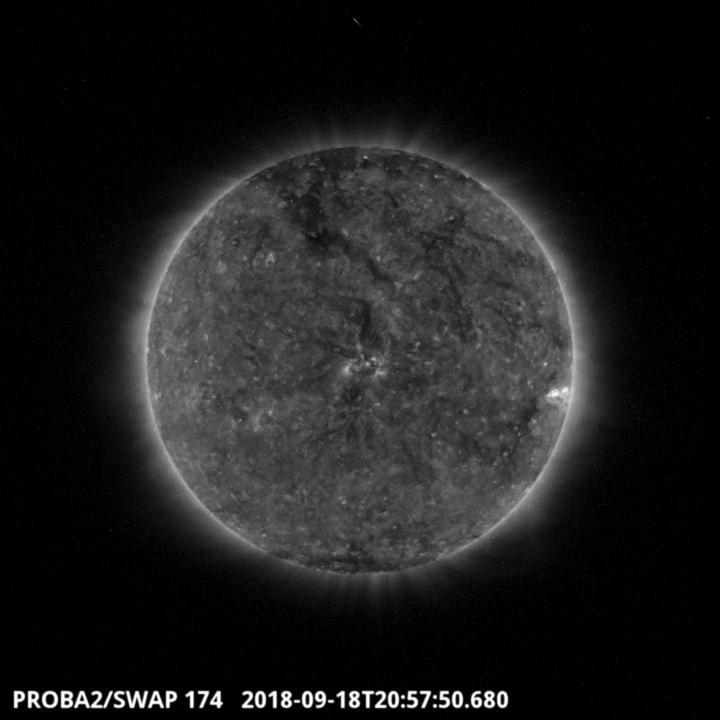
A northern polar coronal hole with a low latitude extension is visible in the SWAP image above, it transited the central meridian on 2018-Sep-18. Find a movie of the event here (SWAP movie)
http://proba2.oma.be/swap/data/mpg/movies/20180918_swap_movie.mp4
Review of geomagnetic activity
The in situ observations at L1 showed a fast solar wind which could be associated with the equatorial coronal hole that reached the central meridian on September 13. The solar wind speed and the magnetic field magnitude reached values of 600 km/s and 13 nT, respectively, in the morning of September 17.
The fast solar wind associated with the low latitude extension of the northern polar coronal hole passed the L1 point on September 22. This fast wind induced disturbed geomagnetic conditions.
The station at Dourbes reported an interval of K=4 at 03:00 UT, September 22, while NOAA reported two 3h intervals of Kp=5 starting, on 21:00 UT, September 21 and 00:00 UT on September 22.
Minor storm conditions (K=5 ) was reported by the Dourbes station from 21:00 UT until 24:00 UT on September 22, in the same time NOAA reported long interval of Kp=4.
Except for these intervals of disturbed geomagnetic conditions, it was quiet to unsettled.
The SIDC space weather Briefing
The Space Weather Briefing presented by the forecaster on duty from Sept 17 to 23. It reflects in images and graphs what is written in the Solar and Geomagnetic Activity report.
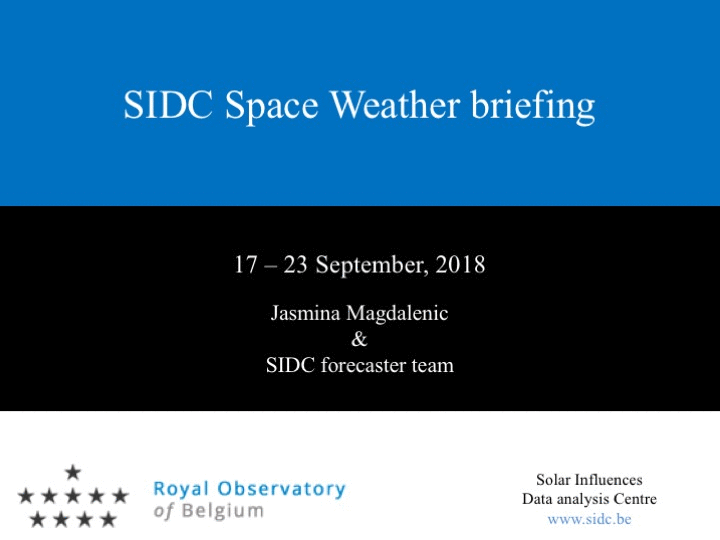
The pdf-version: http://www.stce.be/briefings/SIDCbriefing_20180917_23.pdf
The automatically running presentation: http://www.stce.be/briefings/SIDCbriefing_20180917_23.ppsm
Review of ionospheric activity (17 Sep 2018 - 23 Sep 2018)
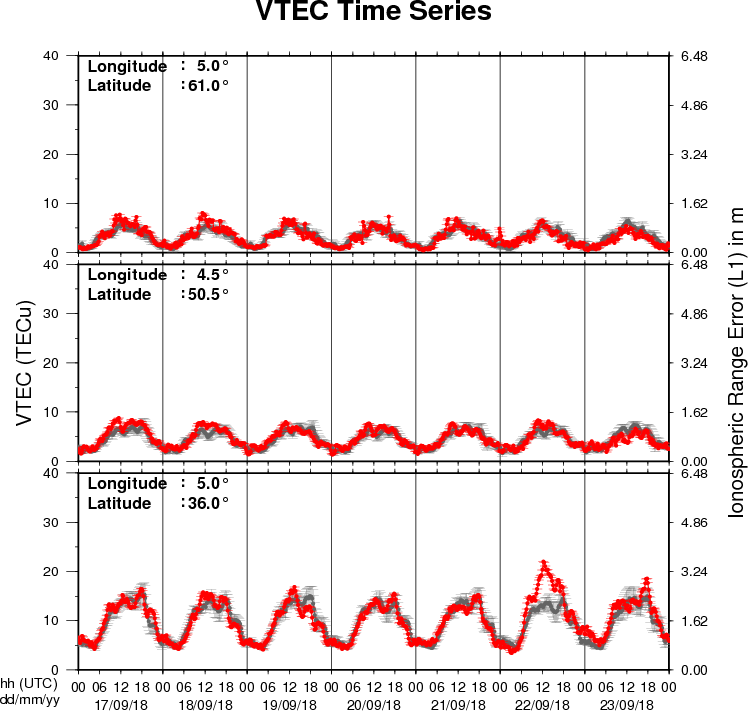
The figure shows the time evolution of the Vertical Total Electron Content (VTEC) (in red) during the last week at three locations:
a) in the northern part of Europe(N61°, 5°E)
b) above Brussels(N50.5°, 4.5°E)
c) in the southern part of Europe(N36°, 5°E)
This figure also shows (in grey) the normal ionospheric behaviour expected based on the median VTEC from the 15 previous days.
The VTEC is expressed in TECu (with TECu=10^16 electrons per square meter) and is directly related to the signal propagation delay due to the ionosphere (in figure: delay on GPS L1 frequency).
The Sun's radiation ionizes the Earth's upper atmosphere, the ionosphere, located from about 60km to 1000km above the Earth's surface.The ionization process in the ionosphere produces ions and free electrons. These electrons perturb the propagation of the GNSS (Global Navigation Satellite System) signals by inducing a so-called ionospheric delay.
See http://stce.be/newsletter/GNSS_final.pdf for some more explanations ; for detailed information, see http://gnss.be/ionosphere_tutorial.php
